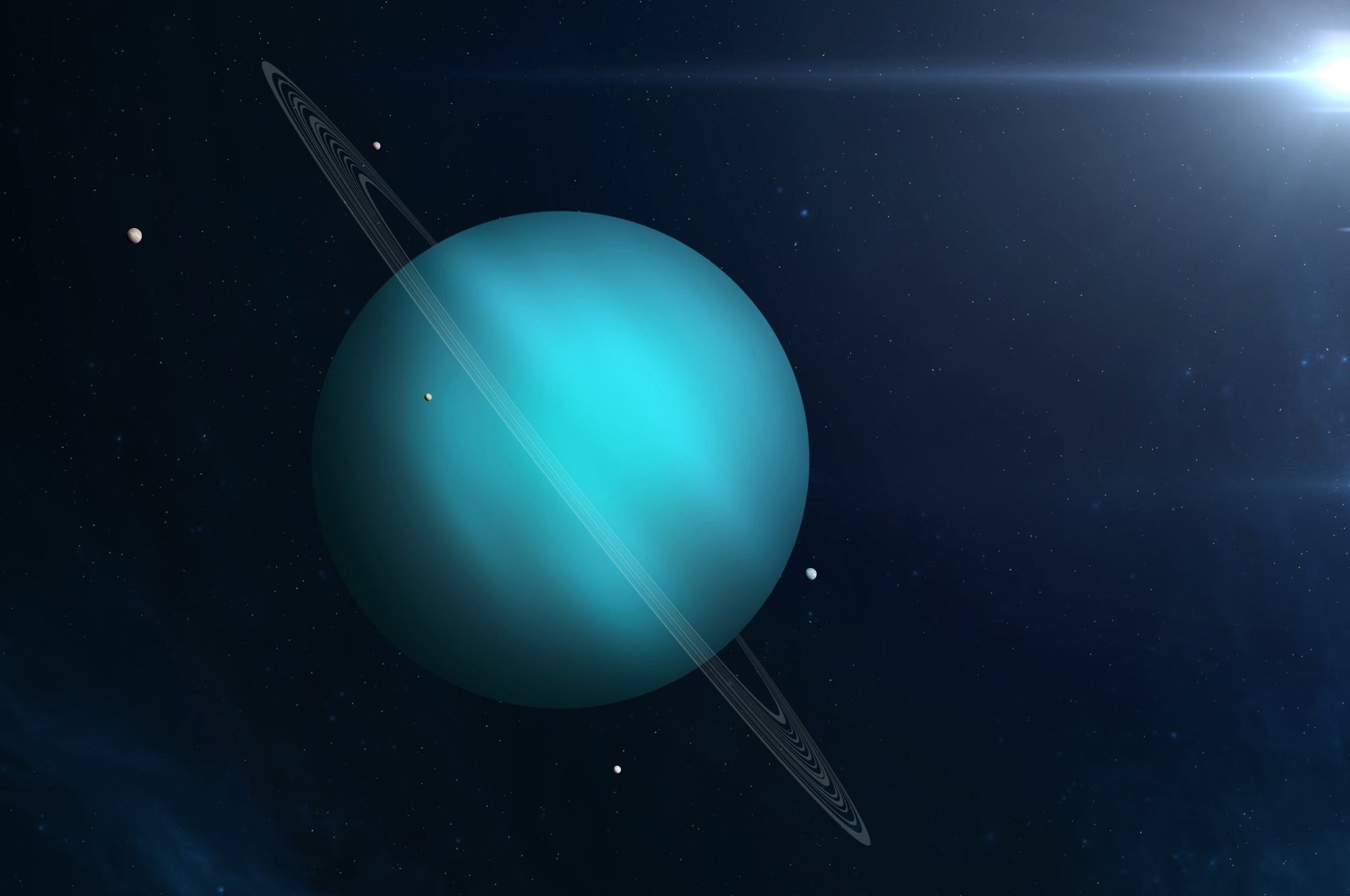In a paper published in Geophysical Research Letters, researchers have been investigating the potential existence of subsurface oceans beneath the icy surfaces of Uranian moons.
 Study: Looking for Subsurface Oceans Within the Moons of Uranus Using Librations and Gravity. Image Credit: buradaki/Shutterstock.com
Study: Looking for Subsurface Oceans Within the Moons of Uranus Using Librations and Gravity. Image Credit: buradaki/Shutterstock.com
These subsurface oceans may have driven substantial tidal heating within the last few hundred million years, potentially shaping the geophysical evolution of the moons. By integrating libration data with the quadrupole gravity field, the researchers could gain deeper insights into the internal structures and historical dynamics of Miranda, Ariel, and Umbriel.
Related Work
Studies of icy moons around Jupiter and Saturn have revealed the existence of subsurface oceans, raising the question of whether Uranian moons might host similar hidden oceans. While techniques like geodetic measurements and magnetic induction have been successful in detecting such features in other systems, the smaller tidal responses of Uranian moons call for new methods of investigation.
Recent efforts have turned to studying forced physical librations—subtle movements that vary depending on a moon's internal structure. By combining this data with quadrupole gravity field measurements, researchers hope to uncover more about the hidden layers within these moons. Understanding their internal structures could also provide clues about their thermal and orbital evolution, offering a window into their complex geophysical histories.
Modeling Uranian Moon Structures
This study employed well-established methods to model the internal structures of Uranian moons. The satellites were modeled as concentric shells of uniform density, using known radius and bulk density values to guide the calculations.
For models without a subsurface ocean, the densities of the icy mantle and rocky core were specified, and the core radius was calculated accordingly. In three-layer models, additional parameters were defined, including the densities of the ice, ocean, and core, as well as the thickness of the ice shell. Core radii in these models were determined through detailed calculations.
Given the small size of the Uranian satellites, the models incorporated high-pressure ice phases, simplifying the structural representation to three layers: ice, ocean, and core. The moons were assumed to be in hydrostatic equilibrium, with their hydrostatic figures calculated using the methodology developed by Tricarico. These figures formed the foundation for analyzing gravitational field asymmetries and forced physical libration amplitudes.
Gravitational field asymmetries and libration amplitudes were calculated based on whether a subsurface ocean decoupled the ice shell. The models also accounted for the finite rigidity of the ice shells, exploring their deformation potential under Maxwell rheology in response to tidal forces.
The study paid particular attention to how deformation might reduce libration amplitudes, especially in thin ice shells on larger satellites. The results aligned with existing research on tidal dynamics, providing valuable insights into the structural configurations of Uranian moons and the potential presence of subsurface oceans.
Libration and Gravity Insights
The study calculated the forced physical libration amplitudes for the five large Uranian satellites under varying conditions and compared them to measurements from Enceladus. Libration amplitude increased with radius and orbital eccentricity but decreased with bulk density and orbital period. Titania and Oberon's outer satellites exhibited smaller libration amplitudes due to their larger semi-major axes.
Meanwhile, Miranda, Ariel, and Umbriel showed similar amplitudes, with opposing effects of proximity to Uranus, eccentricity, and size approximately canceling out. Enceladus, comparable in size to Miranda, had a much larger eccentricity, resulting in greater libration amplitude.
The results illustrated the influence of ice shell thickness on libration amplitude, particularly when a global subsurface ocean mechanically decoupled the ice shell from the rocky interior. In such cases, libration amplitude became inversely proportional to shell thickness.
Variations in core density, modeled to reflect porous or hydrated silicate rock, also affected the calculations. Due to updated eccentricity data, the findings for the 'no-ocean' case were smaller than those of previous studies. Allowing for elastic deformation of ice shells further reduced libration amplitudes compared to the assumption of infinite rigidity.
Measurements of libration amplitudes were found to be useful for detecting global oceans and estimating ice shell thickness but were less sensitive to other structural details like ocean thickness or core properties. However, combining libration measurements with quadrupole gravity field data provided a more comprehensive picture. These combined observations constrained key parameters such as ice shell thickness, ocean thickness, and core density, enabling insights into the internal structure of the Uranian satellites.
The analysis highlighted the synergy between libration amplitude and gravity field data, showing how these measurements could simultaneously constrain the moment of inertia, hydrosphere thickness, and core density. These results underscored the value of integrating libration and gravitational observations to enhance understanding of icy moons' internal configurations.
Conclusion
In conclusion, this study underscores the potential of forced physical libration amplitude measurements as a powerful tool to uncover subsurface liquid water oceans on the Uranian moons.
By providing constraints on key structural parameters such as ice shell thickness, ocean depth, and core composition, these findings advance our understanding of the internal dynamics of these icy bodies. The results suggest that thin ice shells require significant tidal heating to prevent ocean freezing, indicating that some subsurface oceans may be in the process of freezing in recent geological times.
While the low libration amplitudes of Titania and Oberon present measurement challenges, integrating libration data with gravitational field analysis offers a promising approach to overcome these limitations.
Journal Reference
Hemingway, D. J., & Nimmo, F. (2024). Looking for Subsurface Oceans Within the Moons of Uranus Using Librations and Gravity. Geophysical Research Letters, 51:18, e2024GL110409. DOI:10.1029/2024GL110409, https://agupubs.onlinelibrary.wiley.com/doi/10.1029/2024GL110409
Disclaimer: The views expressed here are those of the author expressed in their private capacity and do not necessarily represent the views of AZoM.com Limited T/A AZoNetwork the owner and operator of this website. This disclaimer forms part of the Terms and conditions of use of this website.